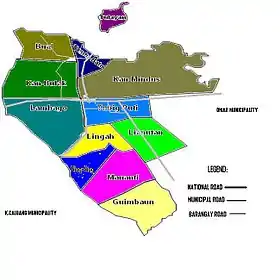Luuk, Sulu
Luuk, officially the Municipality of Luuk (Tausūg: Dāira sin Luuk; Tagalog: Bayan ng Luuk), is a 3rd class municipality in the province of Sulu, Philippines. According to the 2015 census, it has a population of 32,162 people. [3]
Luuk | |
|---|---|
| Municipality of Luuk | |
 Map of Sulu with Luuk highlighted | |
OpenStreetMap 
| |
.svg.png.webp) Luuk Location within the Philippines | |
| Coordinates: 5°58′03″N 121°18′48″E | |
| Country | |
| Region | Bangsamoro Autonomous Region in Muslim Mindanao (BARMM) |
| Province | Sulu |
| District | 2nd District |
| Barangays | 12 (see Barangays) |
| Government | |
| • Type | Sangguniang Bayan |
| • Mayor | Maryam N. Arbison |
| • Vice Mayor | Allayon M. Arbison Jr. |
| • Representative | Munir M. Arbison |
| • Electorate | 19,496 voters (2019) |
| Area | |
| • Total | 313.04 km2 (120.87 sq mi) |
| Elevation | 72 m (236 ft) |
| Highest elevation | 333 m (1,093 ft) |
| Lowest elevation | 0 m (0 ft) |
| Population | |
| • Total | 32,162 |
| • Density | 100/km2 (270/sq mi) |
| • Households | 5,279 |
| Economy | |
| • Income class | 3rd municipal income class |
| • Poverty incidence | 51.89% (2015)[4] |
| • Revenue | ₱79,036,741.06 (2016) |
| Service provider | |
| • Electricity | Sulu Electric Cooperative |
| Time zone | UTC+8 (PST) |
| ZIP code | 7404 |
| PSGC | |
| IDD : area code | +63 (0)68 |
| Climate type | tropical climate |
| Native languages | Tausug Tagalog |
| Website | www |
On July 14, 2007, 8 of its barangays were constituted into the separate municipality of Omar, Sulu.
History
Luuk was the main site of the violent Kamlon Revolt in 1951. This municipality was once a warzone where the government forces and the Muslim rebels would engage frequently for a span of 5–7 years.
Barangays

Political map of Luuk
Luuk is politically subdivided into 12 barangays.
- Bual
- Guimbaun
- Kan-Bulak
- Kan-Mindus
- Lambago
- Lianutan
- Lingah
- Mananti
- Niog-niog
- Tandu-Bato
- Tubig-Puti (Poblacion)
- Tulayan Island
Climate
| Climate data for Luuk, Sulu | |||||||||||||
|---|---|---|---|---|---|---|---|---|---|---|---|---|---|
| Month | Jan | Feb | Mar | Apr | May | Jun | Jul | Aug | Sep | Oct | Nov | Dec | Year |
| Average high °C (°F) | 27 (81) |
27 (81) |
27 (81) |
28 (82) |
28 (82) |
28 (82) |
28 (82) |
28 (82) |
28 (82) |
28 (82) |
28 (82) |
28 (82) |
28 (82) |
| Average low °C (°F) | 27 (81) |
26 (79) |
27 (81) |
27 (81) |
28 (82) |
28 (82) |
27 (81) |
27 (81) |
27 (81) |
27 (81) |
27 (81) |
27 (81) |
27 (81) |
| Average precipitation mm (inches) | 152 (6.0) |
120 (4.7) |
125 (4.9) |
132 (5.2) |
239 (9.4) |
301 (11.9) |
281 (11.1) |
268 (10.6) |
190 (7.5) |
263 (10.4) |
234 (9.2) |
179 (7.0) |
2,484 (97.9) |
| Average rainy days | 17.4 | 14.9 | 15.8 | 15.4 | 22.7 | 24.4 | 25.0 | 23.5 | 20.5 | 22.7 | 21.2 | 18.7 | 242.2 |
| Source: Meteoblue (modeled/calculated data, not measured locally)[5] | |||||||||||||
Demographics
|
| ||||||||||||||||||||||||||||||||||||||||||||||||
| Source: Philippine Statistics Authority [3] [6] [7] | |||||||||||||||||||||||||||||||||||||||||||||||||
References
- Municipality of Luuk | (DILG)
- "Province: Sulu". PSGC Interactive. Quezon City, Philippines: Philippine Statistics Authority. Retrieved 12 November 2016.
- Census of Population (2015). "ARMM – Autonomous Region in Muslim Mindanao". Total Population by Province, City, Municipality and Barangay. PSA. Retrieved 20 June 2016.
- https://psa.gov.ph/sites/default/files/City%20and%20Municipal-level%20Small%20Area%20Poverty%20Estimates_%202009%2C%202012%20and%202015_0.xlsx; publication date: 10 July 2019; publisher: Philippine Statistics Authority.
- "Luuk, Sulu : Average Temperatures and Rainfall". Meteoblue. Retrieved 31 January 2019.
- Census of Population and Housing (2010). "ARMM – Autonomous Region in Muslim Mindanao". Total Population by Province, City, Municipality and Barangay. NSO. Retrieved 29 June 2016.
- Censuses of Population (1903–2007). "ARMM – Autonomous Region in Muslim Mindanao". Table 1. Population Enumerated in Various Censuses by Province/Highly Urbanized City: 1903 to 2007. NSO.
- "Poverty incidence (PI):". Philippine Statistics Authority. Retrieved 28 December 2020.
- https://psa.gov.ph/sites/default/files/NSCB_LocalPovertyPhilippines_0.pdf; publication date: 29 November 2005; publisher: Philippine Statistics Authority.
- https://psa.gov.ph/sites/default/files/2003%20SAE%20of%20poverty%20%28Full%20Report%29_1.pdf; publication date: 23 March 2009; publisher: Philippine Statistics Authority.
- https://psa.gov.ph/sites/default/files/2006%20and%202009%20City%20and%20Municipal%20Level%20Poverty%20Estimates_0_1.pdf; publication date: 3 August 2012; publisher: Philippine Statistics Authority.
- https://psa.gov.ph/sites/default/files/2012%20Municipal%20and%20City%20Level%20Poverty%20Estima7tes%20Publication%20%281%29.pdf; publication date: 31 May 2016; publisher: Philippine Statistics Authority.
- https://psa.gov.ph/sites/default/files/City%20and%20Municipal-level%20Small%20Area%20Poverty%20Estimates_%202009%2C%202012%20and%202015_0.xlsx; publication date: 10 July 2019; publisher: Philippine Statistics Authority.
External links
| Wikimedia Commons has media related to Luuk, Sulu. |
- Luuk Profile at PhilAtlas.com
- Philippine Standard Geographic Code
- Philippine Census Information
- Local Governance Performance Management System
This article is issued from Wikipedia. The text is licensed under Creative Commons - Attribution - Sharealike. Additional terms may apply for the media files.
